- Top
- > Writers and Illustrators
Writers and Illustrators
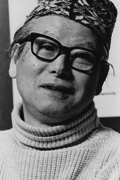
Suekichi Akaba
1910-1990 List of books
Akaba was a creator of picture books who was born in Tokyo, immigrated to Manchuria during his youth, and returned to Japan after the end of World War II. His first picture book Kasa Jizo [Six jizo statues and the braided hats] appeared in 1961. His unique style of illustration exhibited the strong influence of traditional Japanese techniques. Among his most famous works are Daiku to oniroku [Oniroku and the carpenter], Shiroi ryu kuroi ryu [White dragon, black dragon], Momotaro [Peach boy] and Suho no shiroi uma [Suho and the white horse]. He received the Hans Christian Andersen Award for Illustration in 1980.
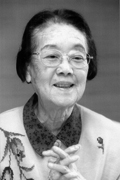
Momoko Ishii
1907-2008 List of books
Ishii was a writer, translator, and editor, who was born in Saitama Prefecture and graduated from Japan Women’s University. Her first major translation of a foreign work was Winnie-the-Pooh, which was published in 1940, after which she translated a great variety of children’s literature and picture books. She wrote her own fanciful children’s novel, Nonchan kumo ni noru [Non-chan rides the clouds] during World War II, and published it after the war. She planned and edited the Iwanami shonen bunko [Iwanami children’s library] and Iwanami no kodomo no hon [Iwanami children’s books] series. After participating in a study group that undertook a critical investigation of contemporary children’s literature, she co-authored Kodomo to bungaku [Children and literature] in 1960. This book had a significant impact on children’s literature and its publishing in Japan by setting out standards intended to ensure that children’s literature was “entertaining, clear, and easy to understand.” In her later years, Ishii published a full-length, autobiographical novel, entitled Maboroshi no akai mi [Phantasmal red fruit]. She also would operate a library for children, called Katsura Bunko, out of her home, during a lifetime that was dedicated to enriching children’s literature.
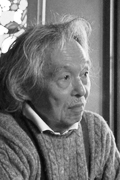
Photograph taken by Akemi Yoshihara
Yosuke Inoue
1931-2016 List of books
Inoue was a creator of picture books, who was born in Tokyo and graduated from Musashino Art School, presently Musashino Art University. Throughout his life, he created his own picture books as well as illustrated the children’s books of others with his strikingly affective drawings. His own picture books include Chotsugai no ehon [The picture book of hinges] and Magareba magarimichi [Around the corner] and works of others that he illustrated include Tadashi Ozawa’s Me wo samase Toragoro [Wake up, Toragoro], Toshiko Kanzawa’s Kuma no ko Ufu [Oof, the bear cub] and Akira Saneto’s Jibetakkosama [Earth god].
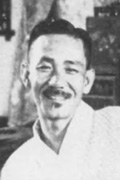
Sazanami Iwaya
1870-1933 List of books
Iwaya was a writer, who was born in Tokyo and began writing novels in his late teens after joining Ken’yusha, a literary group formed by Koyo Ozaki and others. Many of his novels depict puppy love between boys and girls, and he was sometimes referred to as the “writer specialized in children's literature.” Iwaya wrote Koganemaru [A dog named Koganemaru] for the first issue of Shonen bungaku [Children's literature] published by Hakubunkan in 1891. The story became a hit and solidified his stature as a writer of children’s literature. Children found his stories engrossing, so much so that they became known as Sazanami otogibanashi (Sazanami fairy tales). In addition to original works, such as Tosei shonen katagi [The Character of Today's boys] and Shochu kyuka [Summer holiday], he also published his own retellings of a large number of traditional folktales, which included the 24-volume series Nihon mukashibanashi [Japanese folktales], and served as an editor at magazines like Shonen sekai [Children’s world]. In additions to his publications, Iwaya also created a style of story-telling, known as koen dowa (voiced literature) ,that remains noteworthy.
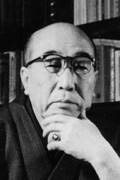
Ranpo Edogawa
1894-1965 List of books
Edogawa was a writer, who was born in Mie Prefecture and graduated from Waseda University’s School of Political Science and Economics. Failing to find steady employment thereafter, he made his literary debut in 1923 when the short story, Nisen doka [The two-sen copper coin], which he wrote while unemployed, was accepted and published in the Shin seinen [New youth] magazine. This was followed with a string of excellent stories that featured unexpected plot twists. Works such as D-zaka no satsujin jiken [The case of the murder on D. hill], Yaneura no sanposha [The stalker in the attic], Ningen isu [The human chair], and other detective stories that compared favorably with similar stories from writers in other countries. In 1936, Kodansha’s Shonen kurabu [Boys' club] magazine commissioned a serial work, which became Kaijin nijumenso [The fiend with twenty faces]. This work was enthusiastically welcomed by children, and the series was followed by Shonen tanteidan [Boy detectives club] and Yokai hakase [A monstrous doctor]. Even after World War II, the Shonen tanteidan series, which featuring ace detective Kogoro Akechi and his young assistant, Kobayashi, continued in Kobunsha’s magazine Shonen [Boy].
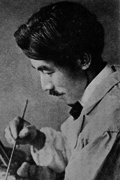
Kiichi Okamoto
1888-1930 List of books
Okamoto was an illustrator of children’s books, who was born on Awaji Island and studied at the Hakubakai School of Western Painting. In 1915, he was responsible for the binding, cover design and illustration of Masao Kusuyama’s translation into Japanese of One thousand and one nights and Gurimm’s fairy tales in Fuzambo Publishing’s Mohan katei bunko [Model family home library] series. His lively drawings of children’s faces illustrated the cover and content of the magazine Kin no fune [The golden boat], which was the first issued in 1919 and subsequently became Kin no hoshi [The golden star]. Okamoto had a deep interest in stage design, producing the costumes and stage sets for the play Aoi tori [Blue bird], which was played at the Yurakuza Theater in 1920. He became a chief illustrator for the magazine Kodomo no kuni [Children’s land], which was founded in 1922. In 1927, together with Takeo Takei and Yoshio Shimizu, he became a founding member of the Nihon Dogaka Kyokai (Japan Association of Illustrators for Children).
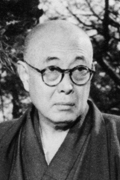
Courtesy of Mimei Ogawa Literature Museum
Mimei Ogawa
1882-1961 List of books
Mimei was a writer, who was born in Niigata Prefecture and began writing novels while a student at Waseda University. After graduation, he became involved in the editing of Shonen bunko [Children’s library] magazine and began writing children’s stories. In 1907, he published his first collection of short stories, Shujin [Bundle of sorrow]. His first anthology of dowa (children’s stories) Akai fune [Red boat] was published in 1910. He declared his intention to concentrate exclusively on writing children’s literature in 1926, and published some 1,200 dowa during his lifetime.
Following World War II, Mimei’s work was criticized for dealing with negative subject matter in long and complicated sentences that were difficult to understand. These criticisms helped drive the shift of children’s literature in Japan away from its prewar style, as represented by Mimei, toward a modern form of contemporary children’s literature.
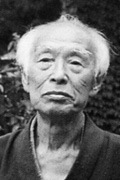
Shiro Kawakami
1889-1983 List of books
Kawakami was an illustrator of children’s books, who was born in Niigata Prefecture and graduated from the Western Painting Department at the Tokyo School of Fine Arts, presently Tokyo University of the Arts. After teaching art at a secondary school, he joined Kodomo-sha, where he illustrated children’s magazines such as Kodomo [Child], Ryoyu [Good friends] and Dowa [Children’s stories]. Having grown up on a farm, his works often feature children in the rural settings. He drew a frontispiece for Shozo Chiba’s collection of folktales, Tote basha [The horn of a village omnibus] and was also responsible for binding, designing and illustrating Chiba’s Wanwan monogatari [The story of a doggie]. Highly acclaimed for line drawings made with an ink pen, Kawakami is considered, together with Takeo Takei and Shigeru Hatsuyama, a pioneer of illustrations for children’s books.
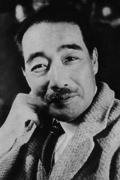
Hakushu Kitahara
1885-1942 List of books
Kitahara was a writer of traditional short poems, known in Japanese as tanka, and was born in Fukuoka Prefecture. After entering Waseda University, he became a contributor to Tekkan Yosano’s magazine Myojo [Morning star]. He published two collections of poems, Jashumon [Heretics] in 1909 and Omoide [Memories] in 1911, which were followed by numerous collections of tanka and other verse. When the children’s magazine Akai tori [Red bird] was launched, he was asked by Miekichi Suzuki both to write lyrics for doyo (children’s songs) and to screen those submitted to the magazine. Kitahara worked to modernize traditional Japanese warabeuta (nursery songs) and published many collections of his own doyo, such as Tonbo no medama [Eyes of a dragonfly]. He also published a translation of Mother Goose entitled Maza gusu in 1921 and a collection of essays on doyo entitled Midori no shokkaku [The feeling of green] in 1929. Of his doyo that were put to music, Kono michi [This path], Karatachi no hana ga saita yo [Orange jasmine is bloom] and Awate tokoya [The busy barber] are still sung today.
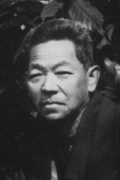
Ioe Saito
1881-1966 List of books
Saito was an illustrator, who was born in Chiba Prefecture and graduated from the Western Painting Department at the Tokyo School of Fine Arts, presently Tokyo University of the Arts. The cover for the first issue of Shonen kurabu [Boys' club] magazine was drawn by Saito in 1914, after which he subsequently created numerous covers, frontispieces, and illustrations for the magazine. His reputation as an illustrator was based on his solid design skills, and he provided illustrations for books such as Koroku Sato’s Aa gyokuhai ni hana ukete [Ah! Flowers in a jade cup] and Shonen sanka [Anthem of youth], Jiro Osaragi’s Sangakuto kidan [Tales of the Sangakuto assassins] and Hanamaru Kotorimaru [Hanamaru and Kotorimaru], and the cover of Eiji Yoshikawa’s Shinshu tenmakyo [Shinshu chivalry].
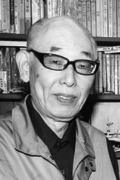
Courtesy of Yurindo
Satoru Sato
1928-2017 List of books
Sato was an author of children’s literature, who was born in Yokosuka City, Kanagawa Prefecture, and graduated from the Department of Architecture at Kanto Gakuin Technical College, presently Kanto Gakuin University. He began writing dowa (children’s stories) and subsequently became a student of writer Takeji Hiratsuka while in college. He joined Gennosuke Nagasaki, Tomiko Inui and others in self-publishing the magazine Mame no ki [Beanstalk] in 1950. After self-publishing full-length fantasy novel Daremo shiranai chiisana kuni [The tiny country that nobody knows] in 1959, the work was soon republished by Kodansha. Depicting the coming of age and self-actualization of a young man during World War II and its aftermath, this work and others like it marked the emergence of modern children’s literature works which are intended for young teens to read by themselves, as opposed to stories intended to be read aloud to young children. The series entitled Korobokkuru monogatari [Tales of Korobokkurus] starts with this book. Sato is also the author of Obaasan no hikoki [Grandma’s airplane], a dowa for young children, and the picture book Ookina ki ga hoshii [I wish I had a big, big tree].
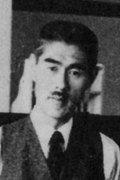
Yoshio Shimizu
1891-1954 List of books
Shimizu was a painter and illustrator of children’s books, who was born in Tokyo and graduated from the Western Painting Department at the Tokyo School of Fine Arts, presently Tokyo University of the Arts. In 1917, he created the cover for Ogoncho [The golden bird], the first book in Miekichi Suzuki’s Sekai dowashu [Collection of world tales for children] series. In 1918, he became the chief illstrator for Miekichi’s Akai tori [Red bird] magazine, creating covers and illustrations throughout the magazine’s existence. His modern style was an excellent match for the doyo (children’s songs) of Hakushu Kitahara and Yaso Saijo. Shimizu also drew a large number of illustrations for picture magazines such as Kodomo no kuni [Children's land], Kodomo no tomo [Children's companion] and Kinda bukku [Kinderbook].
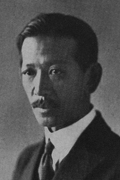
Miekichi Suzuki
1882-1936 List of books
Miekichi was a writer, who was born in Hiroshima City and published his first novel Chidori [The plover] at the recommendation of his instructor, Soseki Natsume, while a student at the School of English Literature of the Tokyo Imperial University, presently the University of Tokyo. His short stories full of poetic sentiment became popular, but he eventually reached a creative impasse and switched to the publishing side of the business. In 1918, he founded the children’s magazine Akai tori [Red bird], which featured works by writers such as Ryunosuke Akutagawa, Takeo Arishima, Koji Uno, Haruo Sato, Toson Shimazaki and Yoshio Toyoshima, as well as by poets such as Hakushu Kitahara, Rofu Miki, and Yaso Saijo, whom Miekichi commissioned dowa (children’s stories) or doyo (children’s songs). During the Free Education movement that occurred during the Taisho era, Akai tori contributed dramatically to raising the level of artistry not just in children’s literature but in Japanese contemporary culture. Composers such as Kosaku Yamada and Tamezo Narita provided music for doyo while artists such as Yoshio Shimizu and Shozo Fukazawa provided doga (illustrations for children) on the magazine. Miekichi himself created titles including Poppo no otecho [Poppo’s small notebook] and Kojiki monogatari [Records of ancient matters].
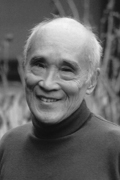
Photograph taken by Ichiro Kikuchi
Shuntaro Tanikawa
1931-2024 List of books
Tanikawa was a poet, who was raised in Tokyo as the only child of philosopher Tetsuzo Tanikawa and his wife, Takiko, who was a graduate of a music conservatory. He began writing poetry while a student of the Tokyo Metropolitan Toyotama high school, at which time he felt uncomfortable at school. His debut as a poet occurred the same year he graduated from high school, when the collection of poems Nero hoka gohen [Nero, and other five poems] was published in Bungakukai [Literary world] magazine at the recommendation of his father’s friend, a poet Tatsuji Miyoshi. In 1952, he published his first book of poetry, Nijuoku konen no kodoku [Two billion light-years of solitude]. In the poem Nero from his debut work, the poet describes the end of childhood while addressing Nero, a puppy who had died.
Tanikawa continued to write poetry and prose for picture books as well as translate children’s stories into Japanese as he continued to unearth rich and deep literary expression of childhood.
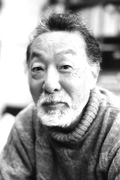
Shinta Cho
1927-2005 List of books
Cho was a manga artist, illustrator, and author of picture books, who was born in Tokyo and is well known for his unique nonsensical picture books illustrated in bold brushwork. In addition to producing picture books such as Boku no kureyon [My crayon], Chiheisen no mieru tokoro [What appeared on the horizon], Kyabetsukun [Cabbage boy] and Watashi [Me], he also designed and illustrated many works such as Yoshitomo Imae’s Yama no muko wa aoi umi datta [Over the mountain there was the blue sea] and Gennosuke Nagasaki’s Aho no hoshi [The star of a fool].
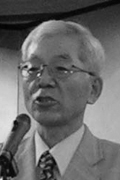
Masamoto Nasu
1942-2021 List of books
Nasu was an author of children’s literature, who was born in Hiroshima City, and experienced the dropping of the atomic bomb at the age of three. He graduated from the Department of Forestry at Shimane Agricultural University. He began writing children’s literature at the suggestion of his elder sister, who herself was an author of children’s literature, Mayumi Takeda. He debuted in 1972 with the novel Kubinashi jizo no takara [The treasure of the headless jizo]. Thought-provoking works such as Yaneura no tooi tabi [Distant journey in the attic] use science-fiction techniques to help children experience what it was like during the war. In 1980, Nasu published Bokura wa umi e [We'll go out to the sea], which was a departure from the idealism that characterizes much contemporary children's literature. On the other hand, from 1978 to 2004, he also published fifty volumes of Zukkoke sanningumi [Funny trio] series. Written in an entertaining manner, this thought-provoking series presented young readers with a variety of problems from the past, present and future, and gained a large following. This series was, in fact, instrumental in exposing children of that generation to a greater range of knowledge than they had known before.
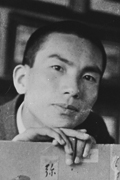
Courtesy of Niimi Nankichi Memorial Museum
Nankichi Niimi
1913-1943 List of books
Nankichi was a writer of dowa (children’s stories), who was born in Aichi Prefecture. He began submitting doyo (children’s songs) and dowa to the children’s magazine Akai tori [Red bird] while working as a substitute elementary school teacher after graduating from Handa Secondary School. Much of his work, including Gongitsune [Gon, the little fox] was first published in Akai tori. He was also associated with the poetry magazine Chichinoki [Ginkgo] put together by followers of Hakushu Kitahara, who screened doyo submitted to Akai tori. Subsequently, he moved to Tokyo and graduated from the Department of English at the Tokyo School of Foreign Languages, presently Tokyo University of Foreign Studies. He eventually found steady employment as a teacher at Anjo Girls' High School, presently Anjo High School, in Aichi Prefecture. His first anthology of dowa, Ojiisan no ranpu [Grandfather’s lamp] was published in 1942. He died a year later at the age of 29 from an illness. Two anthologies were published posthumously: Ushi wo tsunaida tsubaki no ki [The cow tied to the camellia tree] and Hananokimura to nusubitotachi [Hananoki village and the thieves]. Nankichi tells engrossing stories of country life that are still read today, including Gongitsune which appears in elementary school textbooks.
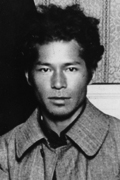
Shigeru Hatsuyama
1897-1973 List of books
Hatsuyama was an illustrator of children’s books and woodblock artist, who was born in Tokyo. After graduating from elementary school, he became a student of Sengai Igawa, an artist who produced Nihonga, Japanese-style paintings. In 1919, after becoming the chief illustrator for Mimei Ogawa’s children’s magazine Otogi no sekai [The world of fairy tales], he began to specialize in doga (illustrations for children). His phantasmagorical style is well known to those familiar with Mimei Ogawa’s dowa (children’s stories). He also published his own picture books, such as Taberu Tonchan [Ton-chan is eating] and Mozu [Shrike], which is a book of woodblock prints.
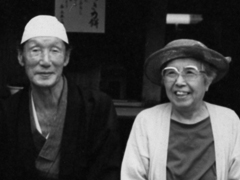
Shozo Fukazawa
1889-1992 List of books
Koko Fukazawa
1903-1993 List of books
Shozo and Koko Fukazawa were a husband-and-wife team of oil painters and illustrators of children’s books, who were both born in Morioka City, Iwate Prefecture. Shozo graduated from Tokyo Art School, presently Tokyo University of the Arts. He provided illustrations for the children’s magazine Akai tori [Red bird], including the illustrations for Yasunari Kawabata’s Kyucho no tantei [Class president as a detective] and Nankichi Niimi’s Gongitsune [Gon, the little fox]. He also illustrated for magazines such as Kodomo no kuni [Children's land] and Kodomo no tomo [Children's companion].
Koko graduated from Women's School of Fine Arts, presently Joshibi University of Art and Design. She provided illustrations for the magazine Kodomo no tomo. She also designed and illustrated Joji Tsubota’s Maho [Magic] and Seika Tatsumi’s anthology of doyo (children’s songs) Yuki to roba [Snow and a donkey].
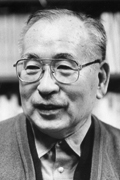
Photograph taken by Eiji Ito
Taruhi Furuta
1927-2014 List of books
Furuta was a critic and writer of children's literature, who was born in Ehime Prefecture. He attended the School of Humanities and Social Studies at Waseda University, but withdrew before graduating. In 1953, while still a student, he participated in publishing a manifesto, called “Shonen bungaku no hata no moto ni” [Under the flag of children's literature] together with Shin Torigoe, Teruo Jingu, Hisashi Yamanaka, and other members of the Waseda Dowa Society. In this work, the authors declared their goal of transcending conventional dowa (children’s stories) to create a new era of children’s literature. Furuta wrote critical pieces and published his first collection of commentary, Gendai jido bungakuron [Discourse on contemporary children's literature], in 1959, as a means to publicize the principles behind this manifesto. In his 1961 novel Nusumareta machi [A stolen town], he put his critical opinions into practice as a writer, speaking directly to children about the issues they faced in their lives. He also published many fine works for young children, including Robotto Kamii [Kammy, the robot]. The picture book he co-authored with Seiichi Tabata, Oshiire no boken [Adventure in the closet], is still popular today.
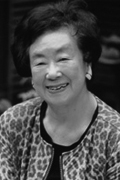
Miyoko Matsutani
1926-2015 List of books
Matsutani was an author of children’s literature, who was born in Tokyo and graduated from Toyo Girls' High School, presently Toyojoshi Senior High School. Matsutani was evacuated from Tokyo and went to live in Nagano Prefecture toward the end of World War II. After the war, she visited writer Joji Tsubota, who had also been evacuated from Tokyo to the area around Lake Nojiri in Nagano Prefecture, and asked him to keep her notebook full of unpublished dowa (children’s stories). In 1948, Matsutani debuted as an author, when Tsubota recommended her story Kai ni natta kodomo no hanashi [The child who turned into a shellfish] for publication in the magazine Dowa kyoshitsu [Classroom of children's stories]. In 1960, she adapted the Shinshu-area legend of Kotaro Koizumi into the full-length novel Tatsu no ko Taro [Taro, the dragon boy], portraying the growth of Taro as he overcomes the poverty of his village. This book has since become one of the hallmark works of in the early era of the contemporary children's literature in Japan. Matsutani was involved in a wide range of activities from publishing stories for young children, such as Chiisai Momochan [Little Momo], picture books such as Inai inai ba [Peek-a-boo], wartime children’s literature such as Futari no Iida [Two little girls called Iida] to collecting contemporary Japanese folklore.
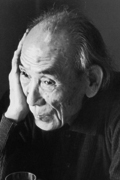
Photograph taken by Eiji Ito
Michio Mado
1909-2014 List of books
Mado was a poet, who was born in Yamaguchi Prefecture. He went to live in Taiwan as an elementary school student and graduated from the Department of Woodcraft at the Auxiliary Industrial Institute, presently National Taipei University of Technology. In 1934, he submitted a doyo (children’s songs) to the picture magazine Kodomo no kuni [Children’s land], which, together with a song by Hakushu Kitahara, was selected to receive a special commendation. From that time, he continued to write doyo and submit them for publication in magazines. After being called up for compulsory military service, he returned to Japan from Singapore at the end of World War II. He worked as an editor for a children’s magazine in Tokyo while continuing to write doyo. During this time he wrote Zosan [Little elephant] and many other famous doyo. His first anthology of poetry, Tenpura piripiri [Tempura piri piri (sizzling)], was published in 1968. In addition to Mametsubu uta [Miniature songs] and other poetry collections, he also published an anthologies of doyo, such as Zosan [Little elephant]. Both his doyo and his poetry use plain language that touches upon the origins of life and of the universe. Winner of the Hans Christian Andersen Award for Writing.
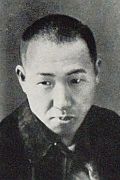
Kenji Miyazawa
1896-1933 List of books
Kenji was a poet, author of children's stories, and teacher of agricultural science, who was born in Iwate Prefecture and graduated from Morioka Agriculture and Forestry College, presently Iwate University. Kenji began writing poems in a traditional short form, known as tanka, while a student at Morioka Secondary School. He was strongly influenced by the book Kanwa taisho myoho rengekyo [Comparison of the Chinese and Japanese Lotus Sutras] edited by Daito Shimaji, and as a student at the Agriculture and Forestry College, he not only admired Masao Katayama’s Kagaku honron [A discourse on chemistry] but began writing dowa (children’s stories). Kenji blends literature, Buddhism, and natural sciences into a unique vision of the world. In 1924, while working as a teacher at Hienu Agricultural School, presently Hanamaki Agricultural High School, he published a collection of poem entitled Haru to shura [Spring and Asura], as well as an anthology of dowa entitled Chumon no ooi ryoriten [The restaurant of many orders]. The collection, which is subtitled Ihatov dowa (Children’s stories of Ihatov), describes life in the land of Ihatov, an imaginary place that is modeled after Iwate Prefecture. Kenji depicts this world as a dreamland, overlaying the harsh realities of poverty with a utopian vision.




















